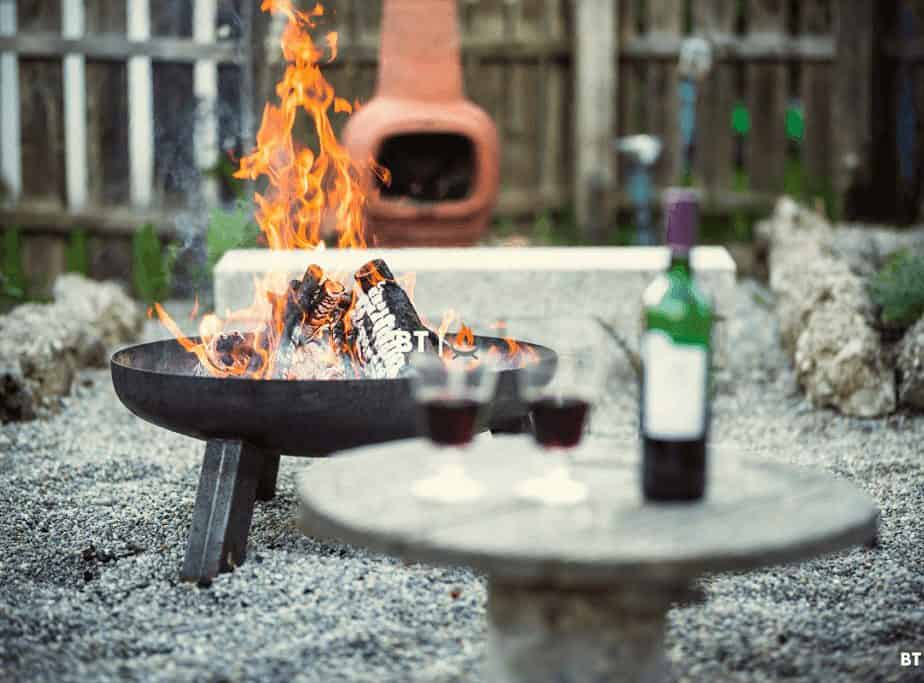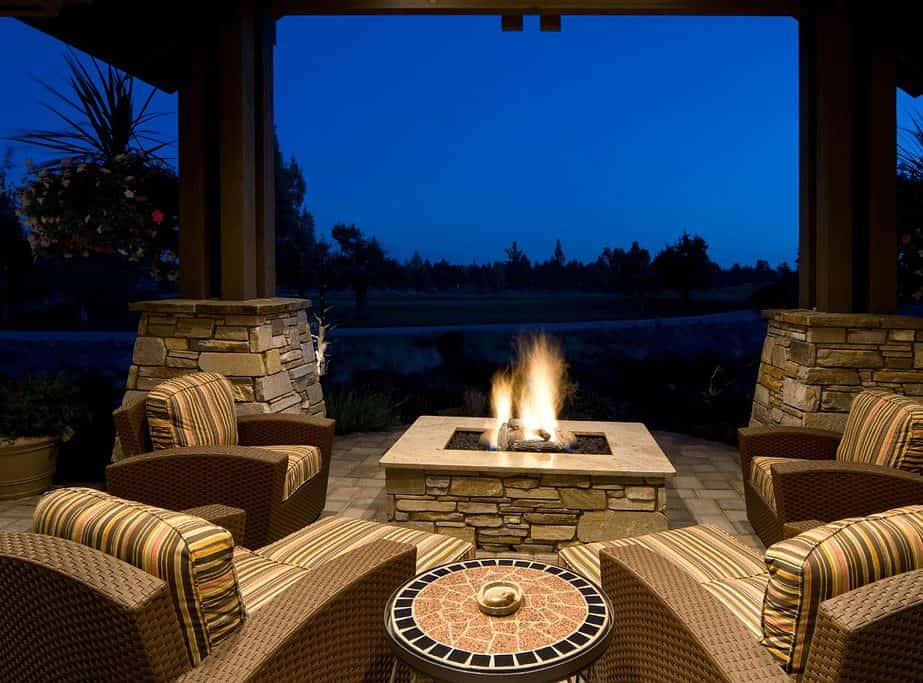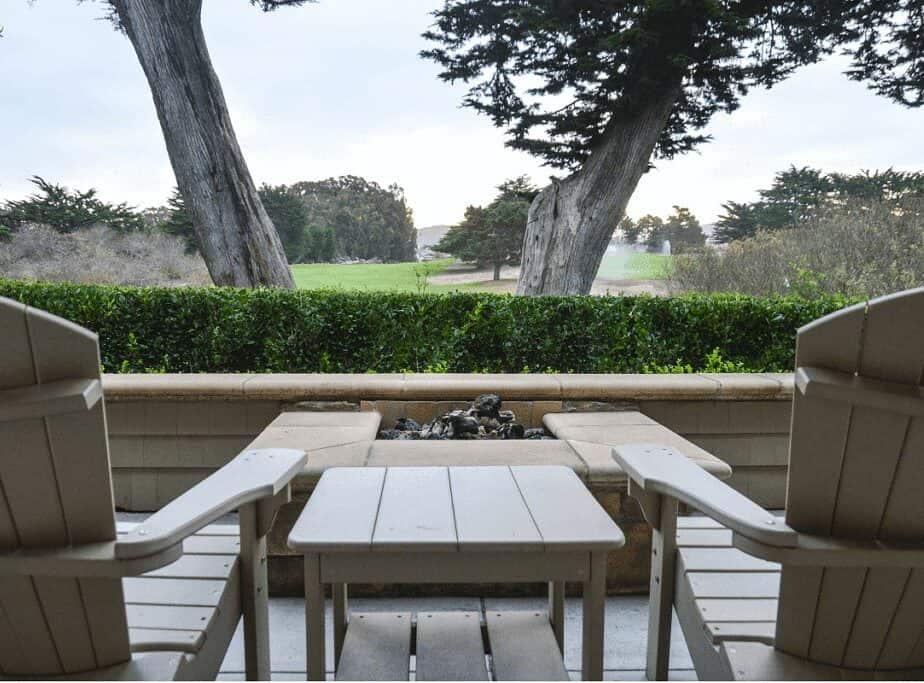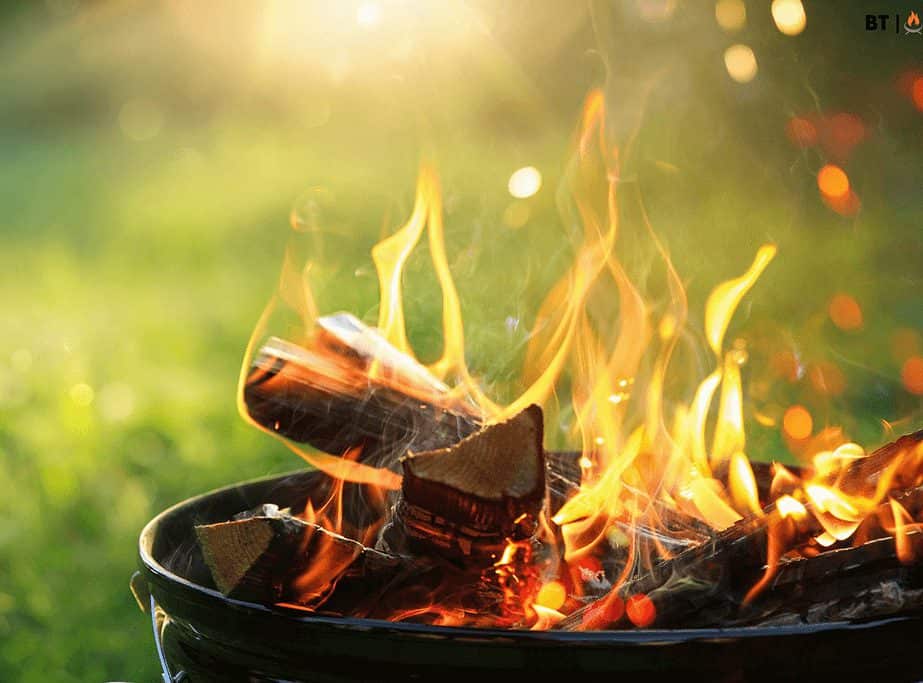By J. Herwick
We use affiliate links and may receive a small commission on purchases.
Read more about us.
This site is about helping you create a safe and relaxing spot for family and friends to socialize, bond, and enjoy each other’s company. Of course, proper fire pit placement is a huge part of that.
Choosing the right location for your fire pit may be your most critical safety decision. Unfortunately, Murphy (as in Murphy’s Law) is always looking to cause mayhem – don’t give him a chance.
Take your time and ensure you pick the best spot for your fire pit, with safety, not convenience or aesthetics, being your guide.
It’s not news that fire is unpredictable, so ensuring your fire pit is in the right spot from the beginning can minimize the risk of serious injury, property damage, and fines.
For this article, the discussion is directed mainly at portable wood-burning fire pits, but the advice is still relevant to placing a fire pit in a permanent fixed location.
Before beginning, check local laws regarding the legal use of fire pits in your municipality. If you have one, consult with your homeowner’s association (HOA) regarding residential fire pit use in your neighborhood once you are familiar with local laws.
Fire pits should be placed on a level surface, no less than ten feet away from any structure, 20-25 feet or more is best, in a wide-open space, away from trees with low-hanging limbs, woodpiles, bushes, and other materials that could ignite if contact with a flame is made. Paved surfaces are ideal, but placement on wood or composite decks and grass are options if fireproof barriers and other precautions are utilized.
According to an NBC article from June 2018, the U.S. Consumer Product Safety Commission reported that the number of fire pit-related injuries in the U.S. has tripled in the last ten years to 5,300, with a quarter of these injuries in children.
This rise in injuries is attributed to the recent increase in the popularity of fire pits. Fire pits can be a very positive and unique component of your family’s time outdoors as long as the risks are understood and adequate time is taken to consider proper placement and other safety factors.

Fire Pit Distance From House
Fire pit placement distance away from the home should be at least 25 feet. This is based on a generally accepted number standard in local fire codes. Check your local fire codes or contact your local fire department for guidelines specific to your area.
Due to the inherent dangers of fire, particularly with regard to wind, dry periods, fuel availability, and a host of other factors, using a number higher than 10 feet is highly encouraged when choosing a spot for your fire pit.
Most sources recommend fire pit placement at 20 to 25 feet or more from the home, structures, and other fuel sources such as trees and limbs, shrubs and bushes, firewood, etc.
The idea is to create enough standoff between the fire pit and anything in the immediate area capable of catching fire. That 20 to 25 feet buffer around the perimeter of the fire pit provides that necessary standoff.

Fire Pit Distance from Trees
As a rule of thumb, don’t place an open flame under anything you don’t want to set fire to. Seems sensible, right?
Common recommendations I’ve found when selecting a sport for fire pits near trees involve trimming the branches back, creating a distance of between ten and 15 feet from the tree, and any of its branches, to the fire pit to minimize the risk of ignition.
I don’t think it’s worth the fire risk and the amount of continuous work trimming branches back. In the end, you can place a fire pit under or near a tree, but you will need to be vigilant about the size of your fire and its proximity to low-hanging tree branches.
Fire Pit Overhead Distance Under Covered Patios
First, a propane gas option will be your best bet if you consider placing a fire pit under a covered patio using a gazebo, pergola, or other structure.
Some wood-burning fire pits produce a considerable amount of heat, smoke, and sparks, which over time can collectively damage and discolor the structure providing overhead cover for the fire pit, not to mention the potential of immediate fire risk.
It’s difficult to get fire pit smoke to go where you want it to without using a chimney, so you’ll want a fire pit with lower emissions of smoke, soot, etc., and that’s where the propane fire pit comes in.
If you go forward with a propane fire pit placement under a covered patio, you will still have to consider the height of the overhead cover and its distance from the fire pit.

The potential fire hazard of an overhead that is too low and the long-term effects of heat from the fire pit will impact the structure’s integrity.
Having your structure’s height set properly will minimize this risk by providing enough clearance for heat to dissipate.
Consult with local authorities and licensed contractors on building/fire codes and your homeowner’s association (HOA) in the beginning stages of any project. Do your due diligence and make sure you comply with the word go.
Look at my article Can You Have a Fire Pit on Your Balcony? for more on safe fire pit placement under a covered area.

Fire Pits on a Wood or Composite Deck
Suppose you are looking to enjoy a new fire pit on an existing outdoor deck consisting of wood or composite decking such as Trex, Fiberon, TimberTech, etc. In that case, it can be done, but you will have to take some steps to safeguard the deck’s structural integrity and finish when choosing a location like this, including choosing a suitable deck-safe fire pit.
In keeping with prior recommendations related to fire pit distance from structures, maintain the 20 to 25 feet distance from the fire pit and your home or any other building nearby when using it on decking of any type.
Also, in keeping with prior guidance, ensure the surrounding area is clear of unintended fuel sources that could ignite due to their proximity to the fire pit.
Pay particular attention to dry leaves, pine needles, and other natural debris that might find its way onto your deck during the year.
To protect your deck from the intense heat generated, you must put a barrier between the fire pit and the deck surface. To save money, use extra concrete pavers you may have around the home from a previous project and slide them together in a grid configuration to create a temporary DIY fire pit safety base.
Commercially available options include pre-fab barrier kits using pavers, steel heat shields, and fire pit pads. The bottom line is, don’t ever put your fire pit directly on your wood or composite deck.
Again, check your local fire codes and HOA covenants before using a fire pit on your deck.
For more on using fire pits on a backyard deck, check out my article, The Ultimate Guide To Using a Fire Pit On Decking.

Using Fire Pits on Grass
Using the recommended safe distances from structures mentioned prior, you can use a fire pit on grass as long as the terrain is level. To use a fire pit on grass, clear the area of unintended fuel sources such as dried leaves, grass, and other flammable debris.
As with the wood and composite decked surfaces, you’ll want to use a temporary barrier between your fire pit and the grass surface. Paving stone arranged in a grid configuration is also a good option here, as are commercially available fire pit safety base options mentioned above in the “Fire Pits on a Wood or Composite Decks” section.
Be sure to remove the paving stones as soon as it is safe to allow the covered spot to bounce back from being covered and under pressure.
The steel heat shield mentioned above could be a good choice here as it has four supports that keep the shield off the ground, allowing airflow and eliminating pressure on the grass.
Be sure to apply water to the grass near the fire pit to protect it from the heat radiating from the fire pit. Again, you’re not soaking the area, just applying enough to keep the grass damp.
Look at my article Fire Pits on Grass: How to Keep Your Lawn From Feeling the Burn for more tips on safely using a fire pit on grass.

Some Final Tips on Fire Pit Placement and Safety
- Never leave any fire pit unattended.
- Maintain very close supervision of children and pets in the vicinity of fire pits
- Moderate alcohol consumption when operating a fire pit; everyone’s safety depends on you being alert and sober enough to take proper action if and when the situation dictates
- Have a water hose, water bucket, or fire extinguisher within arm’s reach of your location near a fire pit
- For wood-burning fire pits: do not use lighter fluid, gasoline, or any other petroleum-based fuel to start a fire in a fire pit;
- Consider using a fire pit screen to contain sparks;
- Utilize log grabbers to add and reposition logs in fire pits;
- When done using the fire pit, extinguish the fire with water and stir the contents until the ash is saturated
For much more on fire pit safety, check out my article, Fire Pit Safety 101: A Primer.
Thanks for reading!
John

